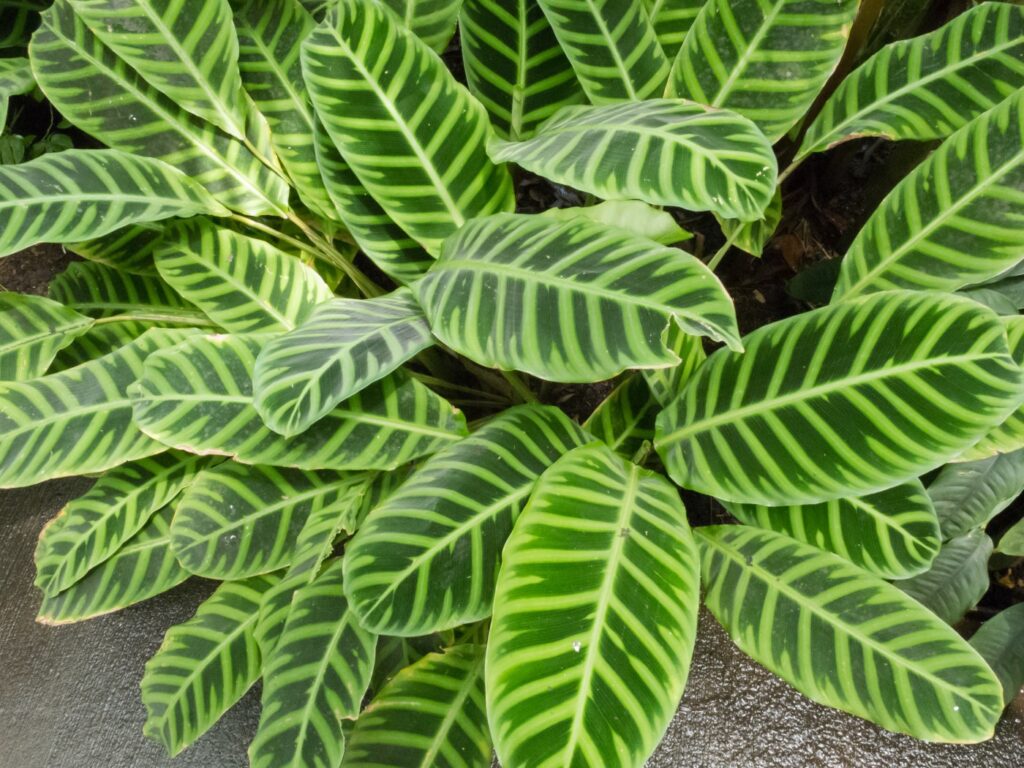Garden Q&A: How do I keep a calathea plant happy?
- January 11, 2024

Q: My calathea is unhappy … browning leaf tips and poor growth overall. How can I help it improve?
A: Welcome to the club. I’ve been in the same boat, along with many houseplant enthusiasts. Calathea remains a popular indoor plant group, but maintains its notoriety for being difficult to grow well and keep in pristine condition.
A common reason for its fussiness is low indoor humidity levels. Given their native habitats, many tropical plants prefer moderate to high humidity, which is hard to achieve indoors here without risking damage to books, furniture, paint, etc. Using a glass- or plastic-enclosed space to retain humidity around plants helps, but most calathea grow large enough that not many terrariums or other structures will fit them as they mature. Plus, stagnant air can pose its own plant health problems if not circulated well with a small fan.
Don’t give in to the temptation to mist foliage – it doesn’t appreciably raise humidity, and leaf surface wetness can make it easier for fungal and bacterial spores to infect foliage. Instead, try using a room humidifier. (Your sinuses and skin may appreciate the moisture boost too.)
Calathea are also sensitive to water quality and potting mix salts. In this context, salts are not limited to sodium but can include any mineral buildup from tap water or unused fertilizer residues. Hard tap water can contain lots of calcium, water softeners may use sodium, and various mineral salts comprise most fertilizer formulations. By occasionally repotting every year or two, you can reset the levels of minerals back to low levels for root health.
Additives in the water you use might be accumulating in foliage or the root zone. For example, fluoride could be a culprit with municipal water sources. One solution may be to use more purified water; not all pitcher-type filters remove every component that could bother plants. Purchasing distilled water might be overcompensating given its cost, though small home distillation units can offset that cost per gallon over time and can have other household uses. I’ve seen purified water have a positive impact on the health of other species sensitive to water quality, such as live sphagnum moss and certain orchids.
Lighting that is too bright could scorch leaves, and too little light could trigger accelerated leaf loss. Correcting growing conditions to ease plant stress won’t fix any leaves already damaged, since they cannot heal, but new growth should look better if the situation is improving. If a plant is still shedding leaves, it might be a normal seasonal reaction: I have two calathea species that have gone dormant at least twice in the several years I’ve been growing them, even though they get the same care as others that remain evergreen.
They summer outdoors in the shade, yet sometimes, by midwinter or so, I fear I’ve killed them since they seem to decline into oblivion and lose all of their leaves. I keep monitoring them both for moisture so they don’t get too dry, and put them outside again after the last frost. Eventually, they resume growth.
If you find yourself in that situation and have the space to keep a declining plant, try to see it through until next spring/summer, when it may gradually rebound during the growing season.
Q: Will cold weather kill insects living in firewood? I was thinking about bringing a bunch of pieces in so I don’t have to restock the stack by the fireplace as often, but heard that might result in bugs coming out.
A: I wouldn’t rely on freezing weather to kill any insects in firewood. (Moving firewood around longer distances is one way invasive species spread, such as the emerald ash borer.) While the split pieces are smaller in volume than the original trunk and therefore would cool down faster than the entire tree would have, winter-hardy insects are still very resilient and are unlikely to succumb to this minor degree of extra cold exposure. Cold-tolerant insects can produce a natural antifreeze that protects their cells from freeze damage to temperatures well below freezing.
If the wood wasn’t debarked, trees with loose bark layers or split wood that has dried enough to loosen its bark may harbor an array of creatures, such as wood roaches, earwigs, and possibly even overwintering yellowjacket wasp queens.
Beetles are a common indoor visitor when firewood containing insects is brought indoors. As it warms up, insects can resume activity and may emerge as adults if they were immature when the wood was cut. Some beetles feed just underneath bark while others tunnel more deeply into heartwood. They could range in size from smaller than a grain of rice to roughly an inch long; black and brown are common colors, but this can vary by species.
They won’t hurt people or pets, nor are they likely to continue their life cycle by infesting other sources of wood in the home (mainly because that wood, being older, is much drier), though it’s best not to tempt fate – leave firewood outside until you’re just about ready to burn it in the next day or two.
University of Maryland Extension’s Home and Garden Information Center offers free gardening and pest information at extension.umd.edu/hgic. Click “Ask Extension” to send questions and photos.
Sign Up For Our
Newsletter
Each day, we honor and remember those who have recently passed away.
Most Viewed
More
- Article Obituaries
- Celebrities
- Celebrity News
- Free Obituary
- Local
- News
- News & Advice
- NFL
- NHL
- Northside
- Norwin
- Obituaries
- Obituary
- Penn Hills
- Pirates
- Pitt
- Pittsburgh
- Plum
- Politics Election
- Premium Memorial
- Sports
- Steelers
- Theater Arts
- Top Stories
- Travel
- Tribune Review Obituaries
- US-World
- Valley News Dispatch
- West End
- Westmoreland
- World